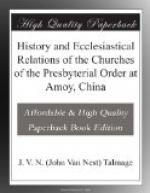We also sent a communication to our Church, addressing it to General Synod. We directed it to the care of one of our prominent ministers, for a long time Secretary of the Board, with the request that it be laid before the Church, using language as follows: “You will, doubtless, receive this paper some months before the time for the next meeting of that Body [General Synod]. We would suggest therefore, that the paper be published, that the members of the next General Synod may have the matter before them, and be the better prepared to make such disposition of it as the subject may demand. We feel that the subject is one of very grave importance,” &c.
Our communication was laid before the Board of Foreign Missions. They designated it a Memorial, and decided that they had no right to publish it. Of course we had no means of publishing it ourselves. It was laid before Synod among other papers of the Board. The action of Synod on the subject was as follows (Minutes of Synod, 1857, pp. 225-227):
“Among the papers submitted to the Synod is an elaborate document from the brethren at Amoy, giving the history of their work there, of its gradual progress, of their intimate connection with Missionaries from other bodies, of the formation of the Church now existing there, and expressing their views as to the propriety and feasibility of forming a Classis at that station. In reply to so much of this paper as respects the establishment of individual churches, we must say that while we appreciate the peculiar circumstances of our brethren, and sympathize with their perplexities, yet it has always been considered a matter of course that ministers, receiving their commission through our Church, and sent forth under the auspices of our Board, would, when they formed converts from the heathen into an ecclesiastical body, mould the organization into a form approaching as nearly as possible that of the Reformed Dutch Churches in our own land. Seeing that the converted heathen, when associated together, must have some form of government, and seeing that our form is, in our view, entirely consistent with, if not required by, the Scriptures, we expect it will in all cases be adopted by our Missionaries, subject, of course, to such modifications as the peculiar circumstances may for the time render necessary. The converts at Amoy, as at Arcot and elsewhere, are to be regarded as ’an integral part’ of our Church, and as such are entitled to all the rights and privileges which we possess.
“And so in regard to the formation of a Classis. The Church at home will undoubtedly expect the brethren to associate themselves into a regular ecclesiastical organization, just as soon as enough materials are obtained to warrant such measure with the hope that it will be permanent. We do not desire churches to be prematurely formed in order to get materials for a Classis, nor any other exercise of violent haste. But we equally deprecate unnecessary delay, believing




